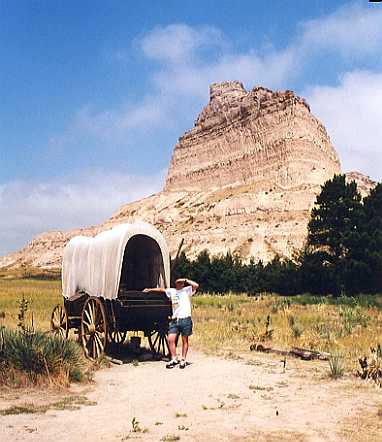|
Agate Fossil Beds
 |
Entelodont
(Dinohyus
hollandi) were large hoofed mammals, nearly 6 feet tall at the
shoulder, with powerful jaws and teeth that identify them as omnivores,
plant and carrion eaters.
Beardog (Daphoenodon - in the foreground) were wolf-sized,
largest carnivores alive 19 to 20 million years ago. |
 |
from left to right :
University Hill and Carnegie Hill.
|
Scotts Bluff National
Monument
 |
20 million years ago,
the surface of the plains was as high as Scotts Bluff - a gently sloping
landscape composed of sediments from uplands to the west. About 5 million
years ago, the Platte River and its tributaries began to erode the high
plains. Bit by bit, water carried away massive volumes of soil and rock,
creating canyons that grew wider and wider.
Scotts Bluff Summit Road. |
 |
The West of the mid 1800s offered
new beginnings to thousands of emigrants. In search of new freedom, many
modes of transportation were used on the trails.
Covered wagon migrations began in 1841. Emigrants bound to Oregon
or California loaded possessions and provisions into small canvas-covered
wagons. Two to four yoke of oxen pulled the wagon, while the family walked
alongside.
During the next seven years, about 15,000 persons (mostly settlers but
including some soldiers, explorers and traders) trekked past the bluffs. |
|

